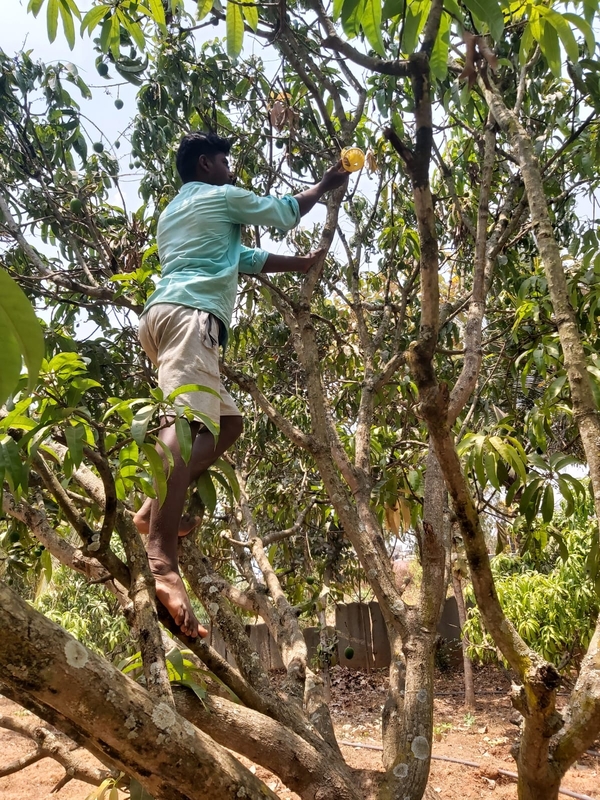Golden honey from Kathmandu, Nepal

Not too long ago, I was invited to visit The International Centre for Integrated Mountain Development, ICIMOD, which is a regional knowledge development and learning centre serving the eight regional member countries of the Hindu Kush Himalayas – Afghanistan, Bangladesh, Bhutan, China, India, Myanmar, Nepal, and Pakistan and based in Kathmandu, Nepal.
“ICIMOD aims to assist mountain people to understand climate changes, adapt to them, and make the most of new opportunities Overall, we are working to develop an economically and environmentally sound mountain ecosystem to improve the living standards of mountain populations and to sustain vital ecosystem services for the billions of people living downstream – now, and for the future,” said Nira Gurung the PR voice of ICIMOD.
While going around the facility we were told that the Hindu Kush Himalayan (HKH) region has a diversity of honeybee species and apicultural practices. The bee keepers in the mountainous areas of the region produce honey from the indigenous honeybee Apis cerana and collect it from wild colonies of Apis dorsata and Apis laboriosa.
Interestingly with the introduction of the European honeybee Apis mellifera, it has led to burgeoning commercial honey production and a search for new markets for honey. The countries of the HKH region now produce more than 20% of all honey sold worldwide.The demand for honey is increasing in domestic, regional, and international markets while production is declining in the European Union (EU) and the Americas as a result of bee diseases and pests.
The EU, Japan, and the United States are the major import markets for honey. However, the countries of the HKH region face large challenges in exporting their honey to these developed countries because of stringent food safety and hygiene regulations and other technical requirements. Among the eight HKH countries only China and India have adequate quality assurance systems in place that allow their honey to be sold to developed countries.
Honey is defined and described by the inter-governmental body for global food standards, as the natural sweet substance produced by honey-bees from the nectar of plants or from secretions of living parts of plants or excretions of plant sucking insects on the living parts of plants, which the bees collect, transform by combining with specific substances of their own, deposit,dehydrate, store, and leave in the honey comb to ripen and mature.
Honey consists essentially of different sugars, predominantly fructose and glucose as well as other substances such as organic acids, enzymes, and solid particles derived from honey collection. The colour of honey varies from nearly colourless to dark brown. The consistency can be fluid, viscous or partly to entirely crystallized. The flavour and aroma vary, but are derived from the plant origin.
Although much of the honey produced in the HKH region is organic or almost organic by default because of the low use of inputs, only small quantities are certified organic. The Codex Alimentarius and European Union standards for organic honey stipulate that bees must be raised without the use of pesticides and other unnatural or harmful substances. In the HKH region only India and Bhutan have standards for organic bee-keeping.
Honey is highly nutritious and a popular health care food (see definition in Box 1). It is said to facilitate better physical performance, is used to cure coughs,colds, wounds, cuts, diarrhoea, and other diseases,and is an important ingredient in many traditional medicines. In recent years, scientific evidence has confirmed the antibiotic and healing properties of honey (Molan 1992).
Honeybees are also of crucial importance for pollinating crops and natural flora.Apart from honey, bee keepers earn income from other bee-related products and services. They sell beeswax for making candles, beauty and healing products; royal jelly and as health foods; and honeybee colonies to other bee keepers. Honey hunting tourism is also a promising source of income. This publication focuses solely on honey production and the trade in honey.
Much of the estimated 86,000 tonnes of honey produced in the HKH region each year is produced by bees that forage a diversity of nectar sources in largely unpolluted natural environments and the crops of subsistence farmers,who use only limited amounts of agrochemicals. Much of the honey from beehives is also unlikely to have unwanted contaminants and residues as it is produced with little or no use of modern inputs such as antibiotics and pesticides.
There is a great potential in the HKH region for organic honey production because of the diversity and richness of honeybee species and floral abundance and the fact that much of the area’s honey is mostly or entirely organic by default as:
� substantial quantities of wild honey are gathered from the nests of wild honeybees and this honey is by definition organic;
� in Nepal, over half (about 500 tonnes) of all honey produced comes from wild floral resources
� the many small-scale backyard bee keepers use hardly any chemicals on their bees and on the crops from which their bees gather nectar.
Organic honey production offers a good opportunity for people in remote mountain communities to earn income in a way that does not harm the environment and helps pollinate crops and wild vegetation. This especially applies to organic honey given that it commands a higher price. Bee keepers who can go a step further and supply certified organic honey can command even higher prices.
“ICIMOD aims to assist mountain people to understand climate changes, adapt to them, and make the most of new opportunities Overall, we are working to develop an economically and environmentally sound mountain ecosystem to improve the living standards of mountain populations and to sustain vital ecosystem services for the billions of people living downstream – now, and for the future,” said Nira Gurung the PR voice of ICIMOD.
While going around the facility we were told that the Hindu Kush Himalayan (HKH) region has a diversity of honeybee species and apicultural practices. The bee keepers in the mountainous areas of the region produce honey from the indigenous honeybee Apis cerana and collect it from wild colonies of Apis dorsata and Apis laboriosa.
Interestingly with the introduction of the European honeybee Apis mellifera, it has led to burgeoning commercial honey production and a search for new markets for honey. The countries of the HKH region now produce more than 20% of all honey sold worldwide.The demand for honey is increasing in domestic, regional, and international markets while production is declining in the European Union (EU) and the Americas as a result of bee diseases and pests.
The EU, Japan, and the United States are the major import markets for honey. However, the countries of the HKH region face large challenges in exporting their honey to these developed countries because of stringent food safety and hygiene regulations and other technical requirements. Among the eight HKH countries only China and India have adequate quality assurance systems in place that allow their honey to be sold to developed countries.
Honey is defined and described by the inter-governmental body for global food standards, as the natural sweet substance produced by honey-bees from the nectar of plants or from secretions of living parts of plants or excretions of plant sucking insects on the living parts of plants, which the bees collect, transform by combining with specific substances of their own, deposit,dehydrate, store, and leave in the honey comb to ripen and mature.
Honey consists essentially of different sugars, predominantly fructose and glucose as well as other substances such as organic acids, enzymes, and solid particles derived from honey collection. The colour of honey varies from nearly colourless to dark brown. The consistency can be fluid, viscous or partly to entirely crystallized. The flavour and aroma vary, but are derived from the plant origin.
Although much of the honey produced in the HKH region is organic or almost organic by default because of the low use of inputs, only small quantities are certified organic. The Codex Alimentarius and European Union standards for organic honey stipulate that bees must be raised without the use of pesticides and other unnatural or harmful substances. In the HKH region only India and Bhutan have standards for organic bee-keeping.
Honey is highly nutritious and a popular health care food (see definition in Box 1). It is said to facilitate better physical performance, is used to cure coughs,colds, wounds, cuts, diarrhoea, and other diseases,and is an important ingredient in many traditional medicines. In recent years, scientific evidence has confirmed the antibiotic and healing properties of honey (Molan 1992).
Honeybees are also of crucial importance for pollinating crops and natural flora.Apart from honey, bee keepers earn income from other bee-related products and services. They sell beeswax for making candles, beauty and healing products; royal jelly and as health foods; and honeybee colonies to other bee keepers. Honey hunting tourism is also a promising source of income. This publication focuses solely on honey production and the trade in honey.
Much of the estimated 86,000 tonnes of honey produced in the HKH region each year is produced by bees that forage a diversity of nectar sources in largely unpolluted natural environments and the crops of subsistence farmers,who use only limited amounts of agrochemicals. Much of the honey from beehives is also unlikely to have unwanted contaminants and residues as it is produced with little or no use of modern inputs such as antibiotics and pesticides.
There is a great potential in the HKH region for organic honey production because of the diversity and richness of honeybee species and floral abundance and the fact that much of the area’s honey is mostly or entirely organic by default as:
� substantial quantities of wild honey are gathered from the nests of wild honeybees and this honey is by definition organic;
� in Nepal, over half (about 500 tonnes) of all honey produced comes from wild floral resources
� the many small-scale backyard bee keepers use hardly any chemicals on their bees and on the crops from which their bees gather nectar.
Organic honey production offers a good opportunity for people in remote mountain communities to earn income in a way that does not harm the environment and helps pollinate crops and wild vegetation. This especially applies to organic honey given that it commands a higher price. Bee keepers who can go a step further and supply certified organic honey can command even higher prices.

Related Articles
Editor's Picks Articles
Top Ten Articles
Previous Features
Site Map
Content copyright © 2023 by Marianne de Nazareth. All rights reserved.
This content was written by Marianne de Nazareth. If you wish to use this content in any manner, you need written permission. Contact Marianne de Nazareth for details.





 -resizeimage.jpg.jpg)

